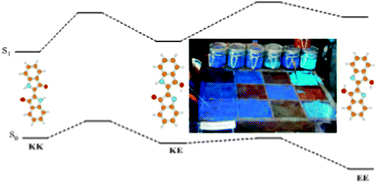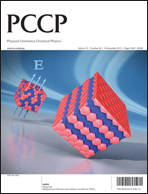A theoretical study of the photochemistry of indigo in its neutral and dianionic (leucoindigo) forms†
Abstract
A thorough analysis of the single and double proton transfer and the internal rotations of neutral indigo and its dianionic leucoindigo form has been performed for the ground and first singlet excited electronic states using, respectively, DFT and TDDFT state-of-the-art methods. Our theoretical analysis discloses that the diketo isomer is the most stable one in the ground state of indigo but not in leucoindigo where the dienol minimum is more stable. Single and double proton transfer processes are not energetically favored in the ground electronic state but a single proton transfer gives a more stable tautomer in the excited electronic state of indigo whereas a double proton transfer is energetically favorable in the excited state of leucoindigo. The internal rotations are not thermodynamically allowed except for the keto–enol tautomer where a full rotation of the inter-ring C–C bond leads to another stable keto–enol structure. A preliminary analysis of the plausible conical intersections for both indigo and leucoindigo allows the discussion of the likely deactivation paths that will follow light irradiation. Our results point to a very different photochemistry of the two molecules. For indigo the proton transfer can only take place through tunneling so the main deactivation path would involve a conical intersection accessed directly upon internal rotation of the keto–keto tautomer. For leucoindigo a richer photochemistry is expected as the single and double proton transfer processes are energetically open. The more favorable path involves single proton transfer followed by a trans to cis isomerization and a second proton transfer. This process competes on equal grounds with several non-radiative decays through conical intersections. All these results are in agreement with the experimental facts known to date.


 Please wait while we load your content...
Please wait while we load your content...